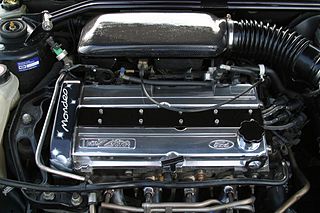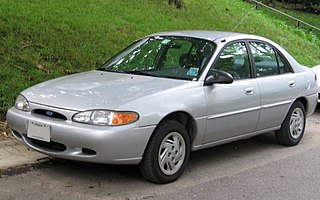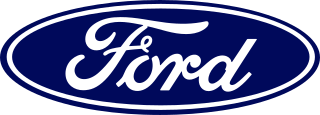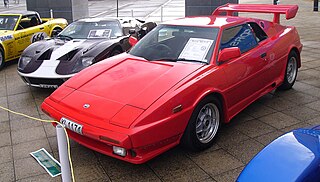
The Ford Sierra was a mid-size or large family car that was built by Ford Europe from 1982 to 1993. It was designed by Uwe Bahnsen, Robert Lutz and Patrick le Quément. The code used during development was "Project Toni". Its name came from the Spanish word for mountain range.

The Ford Kent is an internal combustion engine from Ford of Europe. Originally developed in 1959 for the Ford Anglia, it is an in-line four-cylinder overhead-valve–type pushrod engine with a cast-iron cylinder head and block.

The Ford Fiesta is a supermini marketed by Ford since 1976 over seven generations. Over the years, the Fiesta has mainly been developed and manufactured by Ford's Europe operations, and has been positioned below the Escort.

The CVH engine was introduced by Ford in 1980 in the third generation European Ford Escort and for the 1981 North American Escort. It was later used in the Ford Sierra as well as the second generation Ford Fiesta and from 1983 it was used in the Ford Orion. Engines were built in the Dearborn Engine Plant for the North American market, and in Ford's then-new engine plant in Bridgend in Wales for the European market.

Ford Courier is a model nameplate used by Ford since the early 1950s. First used in North America for a sedan delivery, the Courier nameplate has seen use worldwide for multiple types of vehicles. The Courier nameplate was also used by Ford for a series of compact pickup trucks and would also see use by Ford of Europe denoting a Fiesta-based panel van. Ford Brazil used the nameplate for a Fiesta-based coupe utility pickup marketed across Latin America.

Developed in the late 1980s by the Ford Motor Company, the Ford Zeta engine was a straight-4, double overhead cam internal combustion engine with which Ford had intended to replace the analogous Pinto and CVH models.

The Ford Sigma is a small straight-4 automobile engine introduced in 1995 by Ford Motor Company. Its first evolution was sold as the Zetec-S, then Zetec-SE and finally, in later years, renamed Duratec. The last upgrade of the engine is named Duratec Ti-VCT. Conceived for Ford's smaller models, the motor was intended to replace the older HCS and smaller capacity CVH units.

The Ford Escort is a small family car that was manufactured by Ford of Europe from 1968 until 2000.

The North American variant of the Ford Escort is a compact/small family car introduced by Ford in 1980 for the 1981 model year. Sharing its name with the third-generation European Ford Escort, the model line is the first front-wheel drive Ford developed and sold in North America. The direct successor of the Ford Pinto, as the smallest Ford car in North America, the Escort largely replaced the European-imported Ford Fiesta.
Hewland is a British engineering company, founded in 1957 by Mike Hewland, which specialises in racing-car gearboxes. Hewland currently employ 130 people at their Maidenhead facility and have diversified into a variety of markets being particularly successful in electric vehicle transmission supply.
1980 in motoring deals with developments in the automotive industry that occurred in 1980, listed by country. The automotive industry designs, develops, manufactures, markets, and sells motor vehicles.
1989 in motoring includes developments in the automotive industry throughout the year 1989 by various automobile manufacturers, grouped by country. The automotive industry designs, develops, manufactures, markets, and sells motor vehicles.

Ford of Europe GmbH is a subsidiary company of Ford Motor Company founded in 1967 in Cork, Ireland, with headquarters in Cologne, Germany.

Heron Cars were racing cars, sports and kit cars built in New Zealand between 1962 and 1999 by Ross Baker. They also included a one-off electric car.

Ford Motor Company used the Zetec name on a variety of inline 4-cylinder automobile engines. It was coined to replace "Zeta" on a range of 1.6 L to 2.0 L multi-valve engines introduced in 1991 because Ford was threatened with legal action by Lancia who owned the Zeta trademark. The company used the name widely in European advertising and later introduced it to the North American market with the Contour.

The Ford Fiesta Mk2 was the second generation of the Ford Fiesta supermini built by Ford Europe. Originally introduced in 1983, it was a mild facelift of the original car, and it was available in 3-door hatchback and panel van styles. It was replaced by the heavily updated Fiesta Mk3 for 1989.

The Ford Fiesta Mk3 was the third generation of the Ford Fiesta supermini built by Ford Europe. Originally introduced in 1989, the Mk3 represented the biggest change to the Fiesta since the original car was introduced in 1976. In addition to the 3-door hatchback and panel van versions that had formed the Fiesta range, a 5-door hatchback was also added. The Fiesta Mk3 was replaced by the Fiesta Mk4 in 1995, but remained on sale until early 1997. The Mk4 was a major restyle of the Mk3, but had the same chassis.

The Fiesta Mark IV was launched in October 1995 and became Britain's best-selling car from 1996 to 1998, when it was overtaken by the all-new Ford Focus, a replacement for the Ford Escort.














